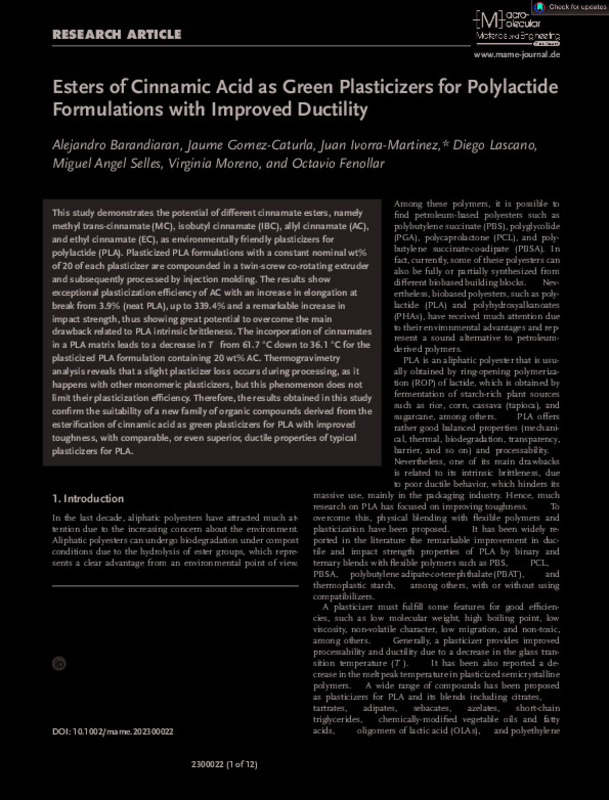|
Resumen:
|
[EN] This study demonstrates the potential of different cinnamate esters, namely methyl trans-cinnamate (MC), isobutyl cinnamate (IBC), allyl cinnamate (AC), and ethyl cinnamate (EC), as environmentally friendly plasticizers ...[+]
[EN] This study demonstrates the potential of different cinnamate esters, namely methyl trans-cinnamate (MC), isobutyl cinnamate (IBC), allyl cinnamate (AC), and ethyl cinnamate (EC), as environmentally friendly plasticizers for polylactide (PLA). Plasticized PLA formulations with a constant nominal wt% of 20 of each plasticizer are compounded in a twin-screw co-rotating extruder and subsequently processed by injection molding. The results show exceptional plasticization efficiency of AC with an increase in elongation at break from 3.9% (neat PLA), up to 339.4% and a remarkable increase in impact strength, thus showing great potential to overcome the main drawback related to PLA intrinsic brittleness. The incorporation of cinnamates in a PLA matrix leads to a decrease in Tg from 61.7 °C down to 36.1 °C for the plasticized PLA formulation containing 20 wt% AC. Thermogravimetry analysis reveals that a slight plasticizer loss occurs during processing, as it happens with other monomeric plasticizers, but this phenomenon does not limit their plasticization efficiency. Therefore, the results obtained in this study confirm the suitability of a new family of organic compounds derived from the esterification of cinnamic acid as green plasticizers for PLA with improved toughness, with comparable, or even superior, ductile properties of typical plasticizers for PLA.
[-]
|
|
Agradecimientos:
|
This research is a part of the grant PID2020-116496RB-C22, funded by MCIN/AEI/10.13039/501100011033 and the grant TED2021-131762A-I00, funded by MCIN/AEI/10.13039/501100011033 and by the European Union "NextGenerationEU"/PRTR. ...[+]
This research is a part of the grant PID2020-116496RB-C22, funded by MCIN/AEI/10.13039/501100011033 and the grant TED2021-131762A-I00, funded by MCIN/AEI/10.13039/501100011033 and by the European Union "NextGenerationEU"/PRTR. Authors also thank Generalitat Valenciana-GVA for funding this research through the grant numbers AICO/2021/025 and CIGE/2021/094. Funding for open access charge: Universitat Politecnica de Valencia. Funded with Aid for First Research Projects (PAID-06-22), Vice-rectorate for Research of the Universitat Politecnica de Valencia (UPV). JaumeGomez-Caturla wants to thank Generalitat Valenciana-GVA, for his FPI grant(ACIF/2021/185) and grant FPU20/01732 funded by MCIN/AEI/10.13039/501100011033 and by ESF Investing in your future. Juan Ivorra-Martinez wants to thank FPU19/01759 grant funded by MCIN/AEI/10.13039/501100011033 and by ESF Investing in your future. Virginia Moreno wants to thank Generalitat Valenciana-GVA for funding a postdoc position through the APOSTD program co-funded by ESF Investing in your future, grant number CIAPOS/2021/67. D. Lascano acknowledge the Margarita Salas postdoctoral grant from the Ministerio de Universidades, Spain, funded by the European Union-Next Generation EU. Microscopy Services at UPV are also acknowledged by their help in collecting and analyzing images. Open access funding provided by Universitat Politecnica de Valencia within the CRUE/UNIRIS gold Agreement.
[-]
|









